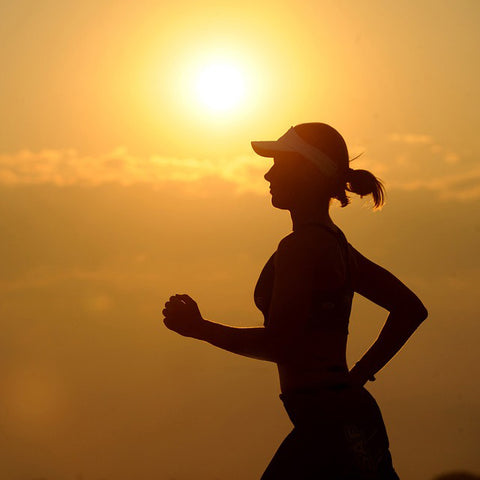
The dog days of summer, as they say, are upon us. As an endurance athlete, you should have a basic understanding of how your body responds to the stress of heat, what you can do to better acclimatize to it, and stay safe while doing it.
How Heat Affects Your Body and Performance
Heat places a tremendous load on your cardiovascular system as you try and keep your body temperature in a safe zone. There are two key things to remember, of which you likely already know:
- Oxygen and nutrients must be delivered in adequate amounts to sustain exercise levels.
- Your body must maintain a stable temperature and sweating is your body’s way of keeping cool.
Keeping these two things in mind, anything that disrupts this delicate balance will affect your performance.
When you exercise, chemicals (hormones and neurotransmitters) are released restricting blood flow to inactive tissues in the body (digestion, reproduction, etc) while increasing blood flow to active muscles. This is a good thing (see # 1 above). When your core or skin temperature increases enough to require cooling, some blood is directed to the skin to promote sweating. This is also good (see #2 above).
Under cooler temperatures, less blood flows to the skin since there is less of a need to sweat allowing more blood to flow freely to the active muscles. During hotter conditions, the skin and active muscle must compete for blood in an effort to maintain the exercise level and stabilize body temperature. As a result, the cardiovascular system must compensate by beating harder and faster to circulate enough blood to sustain your activity. Until adaptation occurs, this negatively impacts your performance. The moral of the story: get adapted to the heat or you’ll be in for a long day of racing/training.
Controlling the Heat: Where does it come from?
Understanding where the heat originates will help you in your attempts to manage your body temperature. There are two primary sources for endurance athletes.
1. Metabolism-A good estimate is that your body will convert 25% of metabolic reactions to usable energy. The remaining amount is given off as heat which raises your core temperature.
2. Radiation-Gaining heat through electromagnetic waves is the next method in which you gain heat. Human skin absorbs about 97% of radiant energy which obviously raises your skin temperature.
If both the skin and core temperature are elevated, from the sun and metabolism for example, performance significantly declines.
When you consider the two primary forms of heat gain (and where they occur), you should be asking how you can minimize this effect? A few suggestions:
- Manage the amount of skin exposure to the sun. Sun sleeves, visors, neck covers and reflective clothing (light colors) prevent heat from reaching the skin. As skin temperature rises, sweating and subsequently skin blood flow must increase to promote cooling.
- Moisture wicking fabric. Plenty is known about keeping the moisture away from the skin which keeps the sweat from collecting and speeds evaporation. When wearing sun sleeves or other sun protective clothing, make sure it is some type of cotton-poly blend that helps with moisture wicking. Don’t wear clothing that will prevent heat from moving away from the body’s surface.
- Get more efficient at generating energy. The above 25% is a generous number for most of us amateurs. It is probably closer to the 22-23% range for most beginners and increasing slightly with skill/experience improvements. A good coach will help you build your efficiency as an endurance athlete.
- Avoid inefficient workouts during the hottest times of the day. You will notice that workouts like hill workouts and high intensity workouts decrease efficiency and generate more heat. Do those workouts during the cooler times of the day when possible. One of the best workouts you can do is longer, less intense sessions that expose you to the heat and drive adaptation.
- Slow down when you begin to get too hot even if it means walking. One problem with heating is called the Q10 effect. As metabolism pushes core temperature up, internal convection (hot blood flowing and heating up surrounding tissue) creates a self-perpetuating cycle driving more blood flow to the skin, increasing sweat loss which depletes fluids and the body’s ability to manage temperature. The primary way to get cooled down at this point is external sources such as applying ice, cold water, wind, etc.
Adaptations to the Heat
The main way to acclimate to the heat is through exposure. As a result of exposure, your body will create more plasma to blunt the competing effects of skin and muscle blood flow. You will also begin to sweat more, sweat sooner, and more evenly over the entire body. This helps keep temperature low early in the exercise session, a proactive approach instead of a reactive approach to keeping cool. Of course, the major take away from this adaptation is that you need to drink more fluids than you normally would since you are now loosing more than in the unadapted state.
To achieve this adaptation, exposure to mid-day like heat can be incorporated once a week. The heat and humidity levels for morning and evening workouts are usually enough to drive adaptation.
Staying on Top of Your Fluid Intake
Hydration is key to adaptation and staying safe. The best way to monitor your fluid intake is to weigh yourself before and after your workouts. You simply need to replace the amount of fluid you lost during your exercise session. While this process often is followed with calculating a sweat rate, the accuracy of sweat rate really depends on several factors such as the intensity, humidity, type of workout, etc. A better way is to make sure you drink what you’ve lost.



